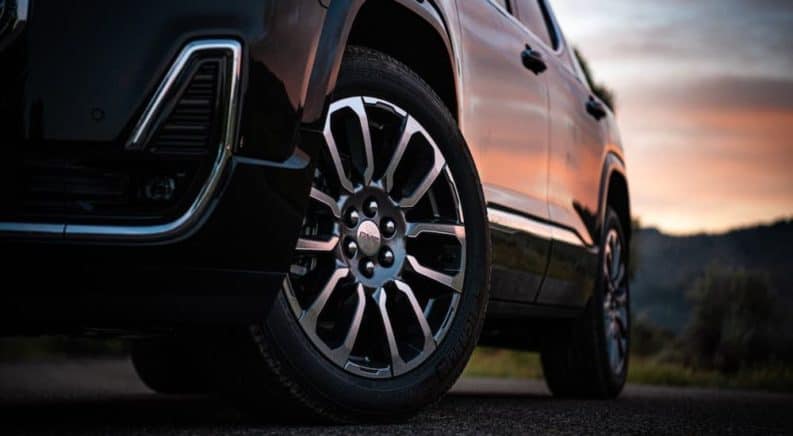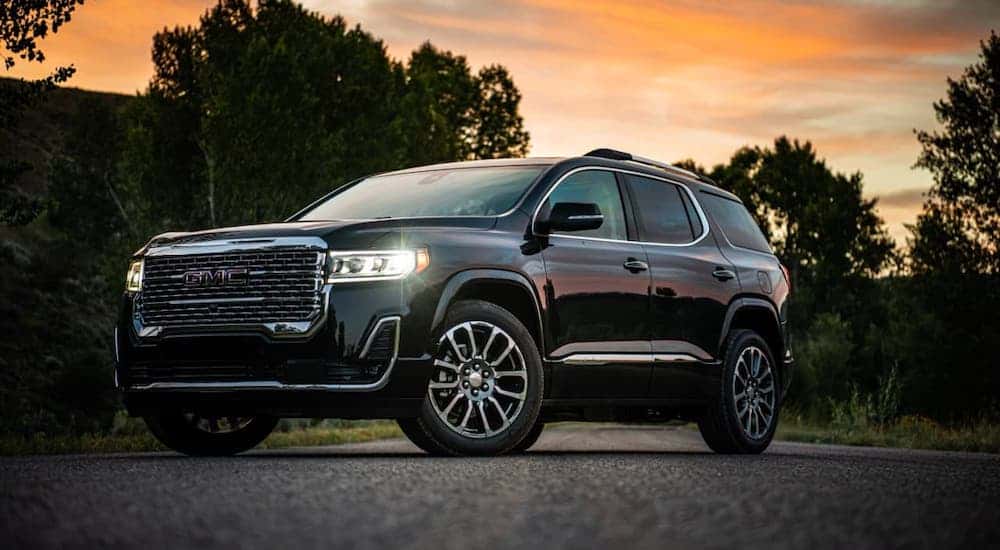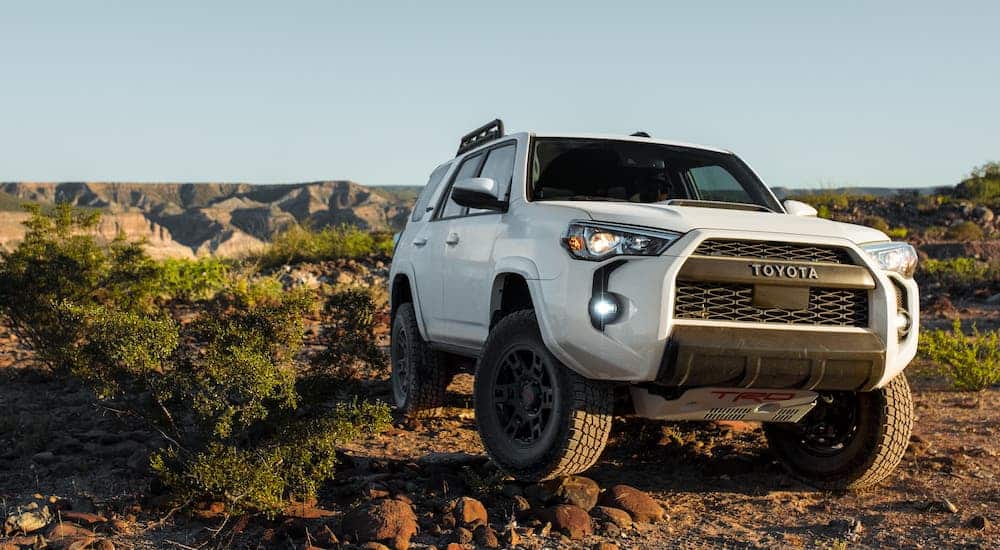A Healthy Competition
In the automotive industry, there are few debates that constantly crop up every year than those surrounding which SUV is the right choice between two contemporaries. This year the trend has continued thanks in part to some fantastic offerings from automotive manufacturers such as GMC. Competition is a healthy thing to have in this industry as many companies look to step into the ring, but often miss the mark. We took it upon ourselves to pit two popular SUVs against each other when we compared the 2020 GMC Acadia vs 2020 Toyota 4Runner.
Both of these SUVs were generally well-received by fans and critics alike, although critics did note advantages for GMC in a few departments, namely the array of engine choices. The Acadia and 4Runner are priced rather similarly, with the latter having a starting MSRP of $36,120 while GMC offers the Acadia for a much lower MSRP of $30,995. Considering that a host of modern feature sets are present in both vehicles such as an up-to-date infotainment system, the price between the Acadia and the 4Runner really works out in GMC’s favor.
Engines That Power These SUVs
GMC offers three different engines across the various trim levels, whereas Toyota only offers a single engine that remains on all trim levels. This means those looking to get the most power out of their SUV will just have to settle with what Toyota gives you. The only engine you’ll find inside of the 2020 4Runner is a 4.0L V6 engine that can produce 270 hp and 278 lb-ft of torque. This is certainly not a bad engine by any stretch of the imagination, but the five-speed automatic transmission sticks out, especially when looking at the higher-level trims compared to the nine-speed automatic transmission you’ll find on each of Acadia’s three engines. The V6 found in the 4Runner has an MPG estimate of 17 MPG in the city, 20 MPG on the highway, and 18 MPG combined, which is outpaced by the base engine found in the Acadia.
The first of the three engines you can equip your 2020 GMC Acadia with may sound familiar to fans of recent Acadia models of the past few years as it’s the same 2.5L I4 engine that’s been featured since the introduction of the second generation of Acadias back in 2017. This engine is capable of 193 hp and 188 lb-ft of torque. For a base engine, it certainly provides ample fuel efficiency as it holds an EPA estimate of 21 MPG in the city, 27 MPG on the highway, and 23 MPG combined with an approximate fuel tank capacity of 19 gallons. There are features found on this engine that make their way over to the next two engines featured on the Acadia, these being Start/Stop technology along with both Variable Valve Timing and Spark Ignition Direct Injection.
Variable Valve Timing results in overall better performance due to the adjusted timing of engine valves closing compared to engines without the capability of adjusting the timing variably. Start/Stop technology is a fantastic feature that, in practice, should help with overall fuel consumption as the engine is able to dynamically turn off once the vehicle comes to a full stop, and the engine will remain off until you remove your foot from the brake. The 4Runner offers its own variant of Variable Valve Timing known as Dual Independent Variable Valve Timing with Intelligence (VVT-i) but lacks the Start/Stop technology that we really enjoyed seeing in the Acadia.
The next engine you can fit your Acadia with is the all-new 2.0L turbocharged I4. This engine provides decent output as it produces 230 hp and 258 lb-ft of torque and includes the features we previously mentioned for the 2.5L I4. We’re still awaiting official EPA estimates for this engine as neither they or GMC have official numbers just yet, and therefore we can’t provide the fuel economy information at this time.
The last engine you can get for your Acadia is the powerful 3.6L V6, which just like the 2.5L I4 engine, is making its return again as it’s been a staple of the Acadia lineup since 2017. This V6 provides 310 hp and 271 lb-ft of torque, which for comparison sake is 40 hp more than the engine found in the 4Runner. The V6 in the Acadia also provides better fuel efficiency than the V6 found inside of the 4Runner as it holds an EPA estimate of 19 MPG in the city, 27 MPG on the highway, and 22 MPG combined which certainly outpaced the 4Runner in this category.
Interior Features
When looking into the interior of these two vehicles, we were pleased to find a seven-seat configuration on the base model Acadia. The maximum number of people you can seat in the 4Runner caps out at five regardless of your configuration. This is very much a good thing for Acadia as holding a reputation of being able to comfortably seat seven people may gain the attention of shoppers looking for an SUV which can do just that. This certainly complements the fact that GMC’s Acadia starts at a lower MSRP than the 4Runner.
Amplifying the feeling of getting a great value with the GMC Acadia is the fact the infotainment system is the same 8-inch size as the one found inside of the 4Runner. Both of these infotainment systems include features such as Sirius XM radio and Bluetooth capability, so you can listen to the music on your phone wirelessly. Speaking of your smartphone, you’ll be pleased to know both Apple CarPlay and Android Auto are on the Acadia this year.
Apple CarPlay and Android Auto allow you to seamlessly connect your phone to the infotainment system and access some of the features found on your smartphone, such as weather information, navigation, and music playback. Both Apple CarPlay and Android Auto feature their own respective app storefronts, and from this, you can customize your vehicle to contain the apps you find the most essential and then personalize the home screen to put said apps front and center. When we put all of these features against one another, it’s apparent that both vehicles contain similar feature sets. But as we mentioned, with the capability of seating seven people while at the same time providing a powerful and efficient ride being intriguing enough, doing so with an overall lower MSRP is even more impressive, and because of this, the Acadia has a lot going for it in more ways than one.
The Verdict
We certainly feel that competition constantly gets more fierce each year. The reason why competition is so healthy in this industry is that it makes manufacturers step back and ask themselves how they’re able to better themselves and create new and exciting experiences than their competitors. This almost always benefits the customer as we get to see revolutionary features appear every now and then since one specific way companies like to improve is through innovation.
The 2020 GMC Acadia and the 2020 Toyota 4Runner are two of the newest SUVs that have people talking. Both vehicles clearly contain their own strengths, but in the end, it was the GMC Acadia that seemed to be the better value. With a rich set of features and a wide range of trims to select from, which more importantly consists of different engine choices, the GMC Acadia simply gives you the most options to customize your ride until it’s just the way you like it.







